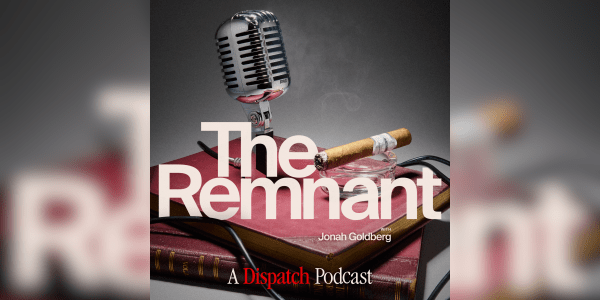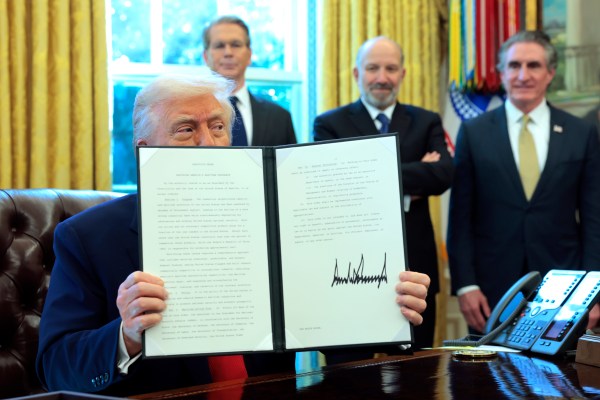An irony of our time: Republicans are on their way to renominating the ultimate cable-news candidate at a moment when cable news looks feebler than it ever has.
Donald Trump brought some of the old magic back to CNN on May 10 for a televised town hall, handing the network a rare landslide ratings win in prime time. But it ain’t like it used to be: The audience of 3.3 million people at 8 p.m. was scarcely bigger than Tucker Carlson’s average viewership on Fox News at the same hour in the first quarter of this year.
And as we’ll see, that audience didn’t stick around in the days following. To the contrary.
“CNN struggles” is a dog-bites-man story, one that bubbles up any time the news cycle slows down considerably for long stretches. “Fox News struggles” is a different animal, pure man-bites-dog. If demand for CNN’s programming is highly elastic, drawing in casual news consumers as major events happen, demand for Fox is normally inelastic. Its viewers don’t tune in primarily to be informed about breaking news, especially in prime time. They watch to get their outrage fix. And the supply of daily outrage bait is inexhaustible.
But demand for Fox’s programming has turned out to be more elastic lately than anyone thought. For different but related reasons, the strongest and weakest major networks in cable news have lost viewers.
Which leaves the wider industry … where?
There’s a reason pieces with titles like “The looming existential crisis for cable news” are appearing lately in major newspapers. Several reasons, actually.
One is the ratings letdown for CNN following the Trump town hall. Executives there plainly hoped the event would pique the curiosity of Republicans tuning in for the first time in ages. The company’s new management has been keen to signal to the right that the overt bias of the Jeff Zucker era will no longer be tolerated.
It hasn’t worked. CNN’s ratings in prime time on the day after the town hall were status quo, scoring between 546,000 and 616,000 viewers—less than half what Fox News and MSNBC pulled across those hours. And it was all downhill from there. On Friday, May 12, two days after the town hall, Anderson Cooper slipped below 500,000 viewers at 8 p.m. and failed to reach 600,000 viewers on any day last week.
Over five weeknights during the same period, the network’s 9 p.m. programming reliably notched about one-third of MSNBC’s audience and one-quarter of Sean Hannity’s. The largest audience at that hour for CNN last week came on Monday, with 454,000 viewers. Rachel Maddow’s MSNBC show topped 2.4 million in the same slot.
The ratings at 10 p.m. were no better. CNN drew fewer than 400,000 on every night last week except one while Fox and MSNBC usually saw audiences of 1.4 million or better.
All in all, according to the Daily Beast, it was CNN’s lowest rated week since June 2015, the month Trump came down the escalator. America’s oldest cable news network isn’t just uncompetitive in prime time lately, it’s being humiliated.
Things are so bad, in fact, that it’s slipped to fourth place behind Newsmax at certain hours.
That’s another reason for the sudden pessimism about the future of the industry. It’s one thing for America’s “hard news” network, the place where normies go to get up to speed when something important happens, to reliably and distantly trail the Fox News juggernaut. But now CNN is lagging behind the right-wing JV team, an amateurish operation whose vibe is “Fox but kookier.” That ignominy feels like a sea change in the industry, the final capitulation of news to propaganda.
On three out of five nights last week, Eric Bolling’s 8 p.m. show on Newsmax topped Anderson Cooper’s, the face of serious news at CNN. On the two nights when Cooper drew a bigger audience, Bolling was within 50,000 viewers of him. Greg Kelly’s 10 p.m. show finished within 100,000 viewers of CNN every night and actually surpassed the network on Friday, when Chris Wallace’s talk show aired in that slot. Wallace had a measly 224,000 viewers that evening compared to Kelly’s 283,000.
An industry in which Chris Wallace is losing to Greg Kelly is an industry in transition, and not for the better.
That brings us to a third reason for pessimism. We’re now almost a month removed from Tucker Carlson’s firing and it’s clear that Newsmax really has inherited a chunk of Tucker’s disaffected viewers. The initial ratings surge after his termination wasn’t a flash in the pan.
On April 24, the day Carlson’s show was canceled, Bolling drew 531,000 viewers for Newsmax at 8 p.m. That was a nearly fourfold jump from the previous Monday, when he had just 146,000. His new audience stayed put on Tuesday, April 25, delivering 562,000 viewers, and hasn’t departed yet. Last week he topped out at 587,000, more than Cooper managed any night that week at CNN.
As you might expect, Newsmax’s gain has been Fox News’ loss. Not once last week did Fox nose past 2 million viewers between the hours of 8 and 11 p.m. ET. Jesse Watters managed it on four out of five nights at 7 p.m. and The Five continued to pull strong ratings (2.4 million or up) at 5 p.m., but prime time—and Tucker’s old slot in particular—is suddenly weaker for Fox than the three-hour bloc that precedes it. Notably, on all five nights, Fox drew a bigger audience at 7 p.m. and at 9 p.m. than it did at 8, suggesting that some viewers are turning the channel during Tucker’s old hour and then turning back.
Whether they’re doing that to protest his firing or because they’ve developed a taste for Bolling’s program is unclear, but as I say, Bolling hasn’t lost his “Tucker bounce” yet. It’s anyone’s guess now whether those viewers will return to Fox in time or if audiences of less than 2 million people at 8 p.m. are the new benchmark of success. Bear in mind that in Bill O’Reilly’s final quarter on the air at Fox, in 2017, he averaged more than 4 million.
“Fox News was down 41 percent in the key demo year-to-year and 24 percent in total viewers,” the Daily Beast reported on Monday about Fox’s ratings last week. “In fact, Fox’s post-Tucker weekday demo audience is the lowest it’s been since the first week of September 2001.”
With a new presidential primary campaign under way and the Trump/DeSantis war beginning in earnest, I did not have “worst Fox ratings in the demo since 9/11” on my bingo card.
Poor ratings would be enough to fuel doomsaying about the future of cable news but Fox and CNN each seem like they’re out of ideas as to how to right their respective ships. CNN’s new management under Chris Licht is suddenly facing a crisis of confidence internally about its handling of the Trump town hall, a spectacle that felt too close to the network’s 2016 vintage for comfort.
And while CNN has shed figures like Don Lemon and Brian Stelter as part of its post-Zucker rebranding, its plan to reinvigorate prime time involves handing the 9 p.m. slot to Kaitlan Collins—a capable reporter (and Zucker holdover, ironically) but not the sort of charismatic presence that might plausibly turn around a struggling network.
Anemic ratings, and therefore irrelevance, seem likely to abide. Things should improve once the presidential campaign gets spicy, but how much?
Fox is also looking in-house to fix its problems in prime time, allegedly. Last week Matt Drudge reported that Sean Hannity will move to 8 p.m., Jesse Watters to 9 p.m., and Greg Gutfeld to 10 p.m. (The fate of Laura Ingraham, the current 10 p.m. host, is unclear.) I thought Fox would feel obliged to appease Tucker’s disgruntled nationalist base by plucking some outré bombthrower from an online platform for the 8 p.m. slot. Instead, if Drudge is right, they’re going to fill that hour with a guy who’s spent nearly 30 years carrying water for the Republican establishment.
Love him or hate him, as unofficial spokesman for the right’s post-liberal vanguard, Carlson was politically relevant in a way no Fox host ever has been. Sean Hannity is the opposite of that. Is airing him at 8 p.m. going to woo back viewers who have switched to Bolling in disgust?
Fox has another problem. It’s made an enemy of Tucker, and a meaningful chunk of populist Republicans is inclined to treat Tucker’s enemies as their enemies.
Leaks have begun to appear lately in right-wing outlets that are designed to embarrass Fox, coincidentally just as Carlson is trying to pressure the network to let him out of his contract. On Monday the Daily Signal revealed that Fox’s company handbook allows employees to use the bathroom that matches their gender identity rather than their biological sex. (As local law requires, incidentally.) Days earlier, Variety reported that a Fox executive told Carlson he was fired at the insistence of Dominion Voting Systems as part of the company’s defamation settlement with the network, although this condition wasn’t memorialized in writing anywhere and Dominion denies it. Tucker himself has begun to promote the claim on social media.
I’m skeptical that Dominion would demand Carlson’s cancellation, as he was a lesser offender in Fox’s “rigged election” shenanigans than, say, Maria Bartiromo was. But I understand why Tucker would want his fans to believe it. It’s part of the effort to reposition Fox as an enemy of his base, one that’s already paying dividends with the usual suspects. The threat to Fox is clear: Unless and until it frees Tucker to work elsewhere, he’s going to do what he can to convince the right that hating the network is a new badge of populist authenticity.
And he may get help in that effort, intentionally or not, from high places.
Grassroots Republicans have always had criticisms of Fox, most famously on Election Night 2020, but never before has the network been at serious risk of those viewers taking sides durably with other media entities against it. They face that risk now in the person of Carlson and, to a lesser extent, Newsmax.
And, perhaps, Elon Musk’s Twitter?
Having failed to build a well-functioning social-media platform or an attractive subscription-based revenue model, Musk seems to be reinventing Twitter as a fledgling right-wing media network.
He has Tucker Carlson himself waiting in the wings to broadcast if and when Fox yields to Tucker’s contract demands. Starting May 30, the mega-successful Daily Wire will also make its podcasts available on Twitter, where they’re at no risk of being demonetized for violating the terms of service. “f Elon Musk stands by his commitment to make Twitter a home for free speech and delivers on monetization opportunities and more sophisticated analytics for content creators, I imagine we will invest even more into the platform,” one of the Daily Wire’s CEOs told Axios.
As I was writing this column, news broke about another coup for Musk and Twitter, one Fox’s news division would have killed for.
Florida Gov. Ron DeSantis will announce he is running for president during a discussion with Twitter CEO Elon Musk, three sources familiar with the plans told NBC News.
Musk and DeSantis will host an event on Twitter Spaces, the site’s platform for audio chats, on Wednesday at 6 p.m. ET. It will be moderated by David Sacks, a tech entrepreneur who is a Musk confidant and DeSantis supporter.
…Even if Musk stops short of a full endorsement of DeSantis, aligning with his presidential announcement puts him and the company more squarely into a presidential election than any other tech company before it.
Rupert Murdoch’s media properties have been famously friendly to Ron DeSantis. For the governor to hand Elon an exclusive as sensational as this one instead of the right’s flagship cable-news network feels … significant.
We all hate, and should hate, when our politicians are Too Online, but it’s reasonable for Team DeSantis to calculate that announcing on Twitter is a simple matter of hunting where the ducks are. If you want to reach the largest possible audience of right-wing populists, which is shrewder? An interview on Fox, which might offend Tucker Carlson fans and draw an audience of 3 million if you’re lucky? Or an interview on Twitter with one of the world’s most influential people, who boasts 140 million followers and could singlehandedly fund your presidential campaign via super PACs if you charm him?
Elon is enough of a player now in right-wing media and politics to make real news as other major players court him. For one night, he and Twitter will be more relevant than Fox is. And probably not for the last time: Recall that Tucker Carlson has reportedly expressed interest in hosting his own Republican candidate forum at some point this year, one that might plausibly outdraw any RNC-sponsored debate. Musk will be keen to have that streamed on Twitter and he’s well positioned to see that it is.
He probably isn’t going to start hiring journalists to compete with Fox News directly. But if the Daily Wire’s example convinces other popular populist pundits to make Twitter their soapbox of choice, one can imagine Musk’s platform gaining relevance at Fox’s expense as the most influential site for right-wing opinion in short order. Imagine Hannity, Watters, and Gutfeld airing on Fox from 8 p.m. to 11 while Twitter offers a “lineup” of Tucker at 8, Ben Shapiro at 9, and Candace Owens at 10.
Who has more viewers? Which has more political juice?
Cable news will have its moments over the next 18 months. The Republican debates will rate well. Some disengaged viewers will start to tune in again as they begin paying more attention to the campaign.
But if something can’t go on forever, it will stop. Cable news can’t go on forever.
Already more Americans get their news online than from television. Cord-cutting continues apace, down from more than 70 percent of households with cable in 2016 to under 40 percent now. As the cable audience shrinks, so will the licensing fees that keep networks like Fox and CNN in business.
All of which makes me think we’ve seen the peak of Fox News’ influence over the American right and of CNN’s influence over the rest of the country. That would be cause for celebration if not for the irresistible trend in modern media toward tailoring the information each individual consumes precisely to their political prejudices. On Fox and CNN, you might still occasionally encounter a stray fact or two that challenges you. In the near post-cable future, when each of our news diets is meticulously curated, never.
Soon many of us will subsist intellectually on what my colleague Chris Stirewalt jokingly calls “News Loaf,” a “news-like product” that replaces actual news with scraps of propaganda, innuendo, half-truths, and misunderstandings promoted by our perfectly tailored individual information feeds. That’s not that different from Sean Hannity’s show, really, but it’s another step from a shared common reality toward an entirely subjective one. How a country can survive on News Loaf, I don’t know.






Please note that we at The Dispatch hold ourselves, our work, and our commenters to a higher standard than other places on the internet. We welcome comments that foster genuine debate or discussion—including comments critical of us or our work—but responses that include ad hominem attacks on fellow Dispatch members or are intended to stoke fear and anger may be moderated.
With your membership, you only have the ability to comment on The Morning Dispatch articles. Consider upgrading to join the conversation everywhere.